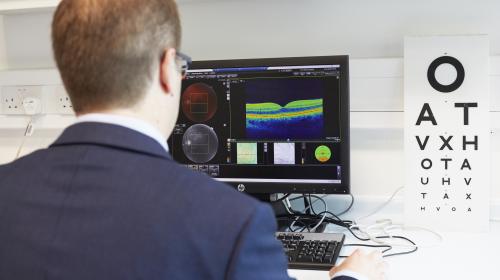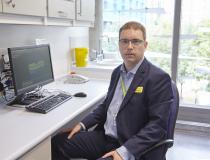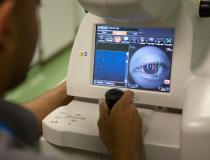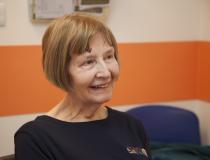Breakthrough in AI technology to improve care for patients
Two years ago, Moorfields Eye Hospital NHS Foundation Trust and DeepMind Health, came together to announce a five-year partnership to explore whether artificial intelligence (AI) technology could help clinicians improve the care for our patients.

Researchers from Moorfields and the UCL Institute of Ophthalmology have had a recent breakthrough in this research, published on Nature Medicine's website, which describes how machine learning technology has been successfully trained on thousands of historic de-personalised eye scans to identify signs of eye disease and recommend how patients should be referred for care.
The AI system can recommend the correct referral decision for over 50 eye diseases with 94% accuracy, matching world-leading eye experts. It is hoped that the technology could revolutionise the way professionals carry out eye tests, allowing them to spot conditions earlier and prioritise patients with the most serious eye diseases before irreversible damage sets in.

Dr Pearse Keane
Dr Pearse Keane, consultant ophthalmologist at Moorfields Eye Hospital NHS Foundation Trust and NIHR Clinician Scientist at the UCL Institute of Ophthalmology said:
“The number of eye scans we’re performing is growing at a pace much faster than human experts are able to interpret them. There is a risk that this may cause delays in the diagnosis and treatment of sight-threatening diseases, which can be devastating for patients.
“The AI technology we’re developing is designed to prioritise patients who need to be seen and treated urgently by a doctor or eye care professional. If we can diagnose and treat eye conditions early, it gives us the best chance of saving people’s sight. With further research it could lead to greater consistency and quality of care for patients with eye problems in the future.”
How does it work

OCT scan
Currently, ophthalmologists use optical coherence tomography (OCT) scans as part of the diagnosis process. These scans allow irregularities and other signs of eye disease to be spotted, however it takes eye health professionals a long time to analyse these highly complex scans, which can impact on how quickly patients can be seen to discuss their diagnosis and treatment.
This study set out to investigate whether AI technology could help improve the care of patients with sight-threatening diseases, such as age-related macular degeneration and diabetic eye disease, by making the analysis of OCT scans faster without losing any of the accuracy in diagnosis.
Using two types of neural network – mathematical systems for identifying patterns in images or data – the AI system quickly learnt to identify ten features of eye disease from highly complex optical coherence tomography (OCT) scans. The system was then able to recommend a referral decision based on the most urgent conditions detected.
To establish whether the AI system was making correct referrals, clinicians also viewed the same OCT scans and made their own referral decisions. The study concluded that AI was able to make the right referral recommendation more than 94% of the time, matching the performance of expert clinicians.
The AI has been developed with two unique features which maximise its potential use in eye care. Firstly, the system can provide information that helps explain to eye care professionals how it arrives at its recommendations. This information includes visuals of the features of eye disease it has identified on the OCT scan and the level of confidence the system has in its recommendations, in the form of a percentage. This functionality is crucial in helping clinicians scrutinise the technology’s recommendations and check its accuracy before deciding the type of care and treatment a patient receives.
Secondly, the AI system can be easily applied to different types of eye scanner, not just the specific model on which it was trained. This could significantly increase the number of people who benefit from this technology and future-proof it, so it can still be used even as OCT scanners are upgraded or replaced over time.
Next steps
The next step is for the research to go through clinical trials to explore how this technology might improve patient care in practice, and regulatory approval before it can be used in hospitals and other clinical settings.
If clinical trials are successful in demonstrating that the technology can be used safely and effectively, Moorfields will be able to use an eventual, regulatory-approved product for free across all 30 of their UK hospitals and community clinics, for an initial period of five years.
The work which has gone into this project will also help accelerate wider NHS research for many years to come. For example, DeepMind has invested significant resources to clean, curate and label Moorfields’ de-identified research dataset to create one of the most advanced eye research databases in the world.
Moorfields owns this database as a non-commercial public asset, which is already forming the basis of nine separate medical research studies. In addition, Moorfields can also use DeepMind’s trained AI model for future non-commercial research efforts, which could help advance medical research even further.
More than 285 million people worldwide live with some form of sight loss, including more than two million people in the UK. Eye diseases remain one of the biggest causes of sight loss, and many can be prevented with early detection and treatment.
Mustafa Suleyman, Co-founder and Head of Applied AI at DeepMind Health, said:
“We set up DeepMind Health because we believe artificial intelligence can help solve some of society’s biggest health challenges, like avoidable sight loss, which affects millions of people across the globe. These incredibly exciting results take us one step closer to that goal and could, in time, transform the diagnosis, treatment and management of patients with sight threatening eye conditions, not just at Moorfields, but around the world.
“We’re immensely proud of this work, which once again demonstrates what is possible when world-leading clinicians and technologists collaborate to improve patient care”.

Professor Sir Peng Tee Khaw
Professor Sir Peng Tee Khaw, director of the NIHR Biomedical Research Centre at Moorfields Eye Hospital NHS Foundation Trust and UCL Institute of Ophthalmology said:
“The results of this pioneering research with DeepMind are very exciting and demonstrate the potential sight-saving impact AI could have for patients. I am in no doubt that AI has a vital role to play in the future of healthcare, particularly when it comes to training and helping medical professionals so that patients benefit from vital treatment earlier than might previously have been possible. This shows the transformative research than can be carried out in the UK combining world leading industry and NIHR/NHS hospital/university partnerships.”
Robert Dufton, chief executive at Moorfields Eye Charity, said:
“The need for treatment for eye diseases is forecast to grow, in part because people are living longer, far beyond our ability to meet the demand using current practice. Artificial intelligence is showing the potential to transform the speed at which diseases can be diagnosed and treatments suggested, making the best use of the limited time of clinicians. AI will also help our understanding of sight loss. Moorfields Eye Charity is proud to have funded equipment which underpins Dr Pearse Keane’s work as part of our programme of philanthropic support in pioneering researchers.”
To find out more about Moorfields Eye Charity and the support provided, please visit their website here.

Elaine Manna, 71, patient at Moorfields Eye Hospital
Elaine Manna, 71, from north London and mother of three, went blind in her left eye from wet age-related macular degeneration (AMD). She is now being treated at Moorfields Eye Hospital to save the remaining sight in her right eye. She said:
“I lost the sight in my left eye in the year 2000 after noticing a sudden blurring of my vision. A few weeks went by and I was starting to get really worried. A doctor then told me I had a bleed at the back of my eye that needed to be treated urgently but it proved too late to save my sight.
“AMD has had a major impact on my life. I love going to the theatre but I find it difficult to see people’s faces and I struggle to find my way around dimly lit rooms. I really hope that technology can help people like me in the future.”
For more resources and information, please use the below links:
Update September 2019: In 2016, Moorfields Eye Hospital NHS Foundation Trust entered into an exciting research partnership with the British technology company DeepMind. In November 2018, it was announced that DeepMind Health would move to Google Health so that the app can grow and support more doctors to deliver faster, better care to patients. In September 2019, after careful consideration, we have now replaced our partnership agreements to continue our work with Google Health.





